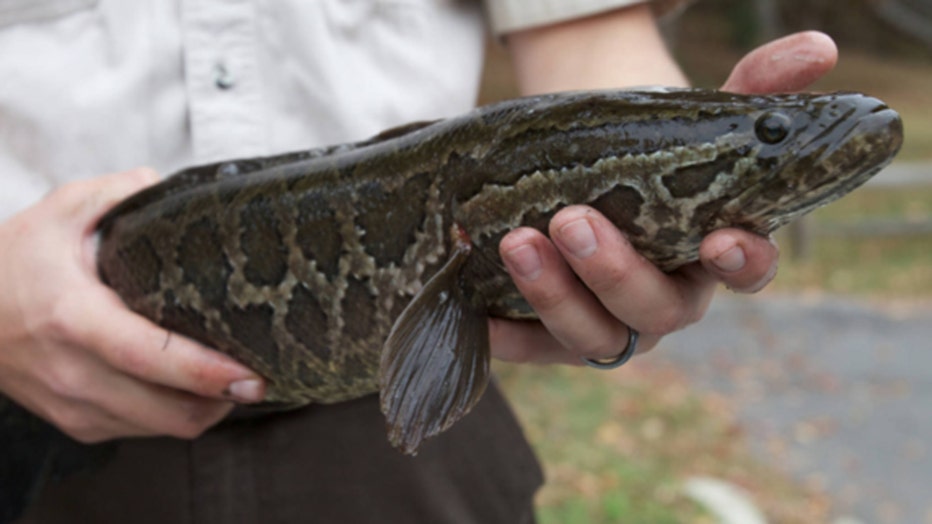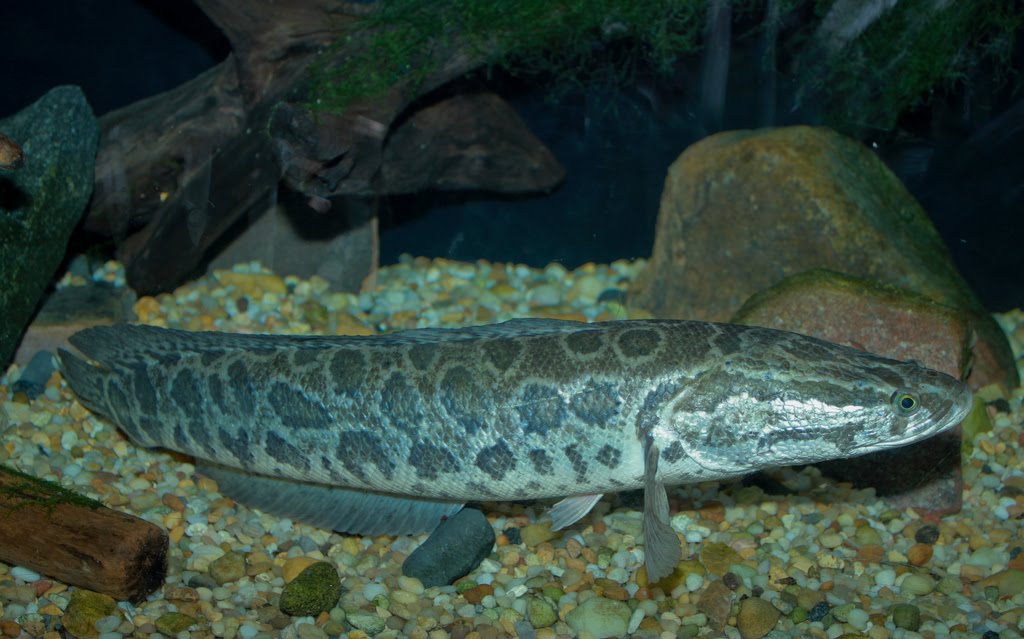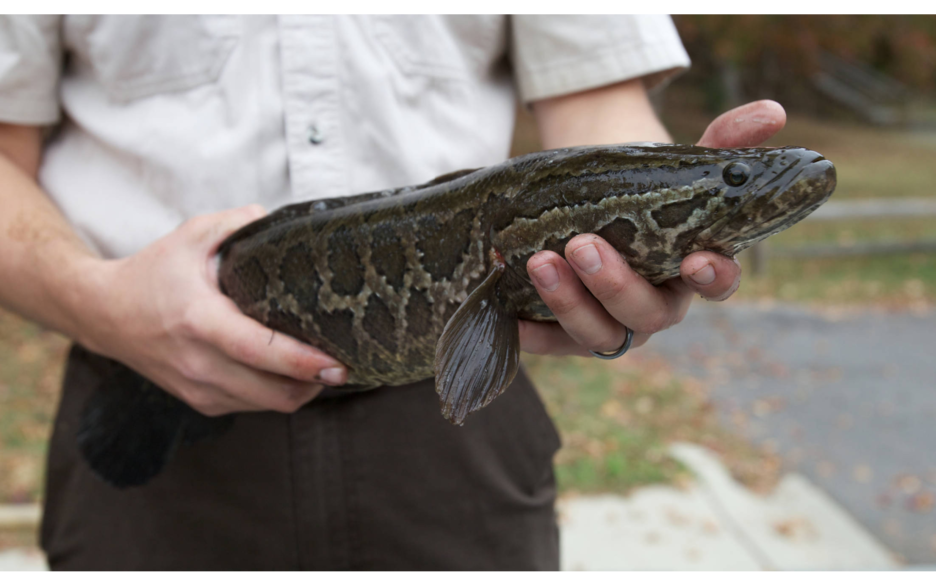
Ministère de l'Énergie et des Ressources naturelles (in French). ^ "Des espèces dangereuses pour la faune aquatique - Un poisson tête-de-serpent découvert dans la rivière Saint-Charles".
 ^ The Associated Press (24 September 2003). Archived from the original on 21 August 2007. ^ a b "Giant snakehead found in Wisconsin waters (News item)". National Invasive Species Information Center. ^ a b Maddern, Mark (14 November 2014). "Cage culture a conservation strategy for an endangered murrel Channa micropeltes." Proceedings of Seventh Kerala Science Congress. "Studies on some aspects of the Culture of murrels Channa micropeltes, Channa marulius and Channa striatus." PhD Thesis University of Kerala. Chiana Micropeltes Archived at the Wayback Machine USGS Circular 1251: Snakeheads (Pisces, Chinnidae) - A Biological Synopsis and Risk Assessment. Unraveling a 146 Years Old Taxonomic Puzzle: Validation of Malabar Snakehead, Species-Status and Its Relevance for Channid Systematics and Evolution. ^ a b c Benziger A, Philip S, Raghavan R, Anvar Ali PH, Sukumaran M, et al. ^ a b c d e Froese, Rainer Pauly, Daniel (eds.) (2014). It was later determined to be a hoax the fish had actually been found dead in a street. The claim of this catch is highly peculiar, as it was reportedly caught in late winter, and being a tropical species, it would not have been able to survive, let alone feed in an English river during winter. micropeltes was reportedly caught by an angler while fishing for pike on the River Witham in Lincolnshire, England. The species is present as an invasive species in Sun Moon Lake in Taiwan. In 2010, one was found dead on the shores of the Saint-Charles River, in Quebec City, Canada. Biologists were concerned that warmwater effluents could allow the tropical species to survive in colder climates, but as yet there is no evidence of established populations anywhere in the United States, with all catches believed to be aquarium releases. In 2003, an example was caught in Rock River, Wisconsin. In Maryland, three specimens were caught in the early 2000s, two in open waters and one in the shallows of the Inner Harbor in Baltimore. It is not believed to be established in the U.S., however, unlike the northern snakehead ( C. micropeltes has been reported in six US states: Maine, Massachusetts, Tennessee, Wisconsin, Maryland and Rhode Island. It is found to be an effective tool in controlling the overpopulation of tilapia, which checks the stunted growth of tilapia.Īs the result of human introductions, C.
^ The Associated Press (24 September 2003). Archived from the original on 21 August 2007. ^ a b "Giant snakehead found in Wisconsin waters (News item)". National Invasive Species Information Center. ^ a b Maddern, Mark (14 November 2014). "Cage culture a conservation strategy for an endangered murrel Channa micropeltes." Proceedings of Seventh Kerala Science Congress. "Studies on some aspects of the Culture of murrels Channa micropeltes, Channa marulius and Channa striatus." PhD Thesis University of Kerala. Chiana Micropeltes Archived at the Wayback Machine USGS Circular 1251: Snakeheads (Pisces, Chinnidae) - A Biological Synopsis and Risk Assessment. Unraveling a 146 Years Old Taxonomic Puzzle: Validation of Malabar Snakehead, Species-Status and Its Relevance for Channid Systematics and Evolution. ^ a b c Benziger A, Philip S, Raghavan R, Anvar Ali PH, Sukumaran M, et al. ^ a b c d e Froese, Rainer Pauly, Daniel (eds.) (2014). It was later determined to be a hoax the fish had actually been found dead in a street. The claim of this catch is highly peculiar, as it was reportedly caught in late winter, and being a tropical species, it would not have been able to survive, let alone feed in an English river during winter. micropeltes was reportedly caught by an angler while fishing for pike on the River Witham in Lincolnshire, England. The species is present as an invasive species in Sun Moon Lake in Taiwan. In 2010, one was found dead on the shores of the Saint-Charles River, in Quebec City, Canada. Biologists were concerned that warmwater effluents could allow the tropical species to survive in colder climates, but as yet there is no evidence of established populations anywhere in the United States, with all catches believed to be aquarium releases. In 2003, an example was caught in Rock River, Wisconsin. In Maryland, three specimens were caught in the early 2000s, two in open waters and one in the shallows of the Inner Harbor in Baltimore. It is not believed to be established in the U.S., however, unlike the northern snakehead ( C. micropeltes has been reported in six US states: Maine, Massachusetts, Tennessee, Wisconsin, Maryland and Rhode Island. It is found to be an effective tool in controlling the overpopulation of tilapia, which checks the stunted growth of tilapia.Īs the result of human introductions, C. 
This fish is reported to be highly suitable for culture in cages or ponds in combination with tilapia. micropeltes for the Squtheast Asian population). In 2011, the Southeast Asian and Indian populations were found to be separate species, with the latter correctly named C. The Indian population was speculated to be from an early human introduction, prior to the 19th century. It used to be believed to have an oddly disjunctive distribution, inhabiting both Southeast Asia and southwest India, about 2,500 km (1,600 mi) apart. micropeltes is found in Southeast Asia, Malay Peninsula, and Indonesia. diplogramma, which used to be considered a synonym of C. The Indian population (red), referred to as "introduced", is actually C.

They can successfully be housed, though, with silver arowanas, clown knifefishes, oscars, and other fish from same size group.ĭistribution of Channa micropeltes, USGS 2004. Due to this, they are called "freshwater great whites".

They are voracious predators that will chase and eat anything that fits in their mouths. Some are even sold as feeders to be fed to larger carnivorous fish. They are commonly sold as juveniles as pets. micropeltes, frequently referred to as the red or redline snakehead in the fishkeeping hobby, is a popular fish to be sold in the pet trade. In various Asian cultures, eating this fish is believed to help in healing of the body, for example, after surgery or severe cuts and scrapes. In Thailand, this fish is prepared in a variety of ways, especially grilled, being a common food item offered by street vendors. The giant snakehead is also a good fish to eat, and is often served in Chinese restaurants. In Malaysia and Singapore, they are known locally as the toman, while in Indonesia they are called gabus or haruan (not to be confused with another species of smaller snakehead known as the common snakehead also called haruan), and are cultured in fish ponds and reservoirs as game fish because they put up a strong fight when hooked. Pla buang is a northern Thai dish of sun-dried and deep-fried giant snakehead








 0 kommentar(er)
0 kommentar(er)
